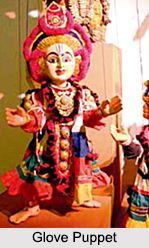 Puppet theatre in Orissa is quite popular. It is a folk art of the state which is found existing in four different forms. It is interesting to note here that this is a rather old art form as in India puppet theatre preceded the human theatre. The Sutradhara referred to by Bharata in his Natyshastra refers to `one who holds the string`, literally the one who introduces the play. By extending the comparison of a string holder in string puppetry to `Sutradhara` in human drama, the ancient dramaturgists implied that the Sutradhara plays the same key role in a human drama as the string -holder - puppeteer plays in a puppet drama.
Puppet theatre in Orissa is quite popular. It is a folk art of the state which is found existing in four different forms. It is interesting to note here that this is a rather old art form as in India puppet theatre preceded the human theatre. The Sutradhara referred to by Bharata in his Natyshastra refers to `one who holds the string`, literally the one who introduces the play. By extending the comparison of a string holder in string puppetry to `Sutradhara` in human drama, the ancient dramaturgists implied that the Sutradhara plays the same key role in a human drama as the string -holder - puppeteer plays in a puppet drama.
There are four kinds of puppetry found in Orissa, namely Shadow puppet, String puppet, Glove puppet and Rod puppet. These are briefly discussed below.
Shadow Puppet
Shadow puppet in Orissa is locally known as the Ravana Chhaya. Shadow puppetry is the puppet theatre form where puppets throw coloured shadows on the screen. The tradition of shadow theatre survives in Orissa, Kerala, Andhra Pradesh and Karnataka.
 The Ravan Chhaya presents the stories of Lord Rama and follows the text of `Vichitra Ramayana` by Vishwanath Khuntia, a medieval Oriya poet. The puppets used in Ravana Chhaya are made of deer skin. These puppets are small in size, not more than 2 feet in height. A lamp is the chief source of light. The puppeteers sit on the ground and move the puppets in between the lamp and the screen. The leader of the group stands on the other side of the screen in full view of the audience. He holds in his hands a Khanjani, a type of small Tambourine with Cymbals. He plays on it while singing. Vocalists often assist him from behind the screen. The group usually consists of 4 members. The prose dialogues are delivered in recitative manner. The music is simple, but the words and vocal accompaniment are very much influenced by Odissi music.
The Ravan Chhaya presents the stories of Lord Rama and follows the text of `Vichitra Ramayana` by Vishwanath Khuntia, a medieval Oriya poet. The puppets used in Ravana Chhaya are made of deer skin. These puppets are small in size, not more than 2 feet in height. A lamp is the chief source of light. The puppeteers sit on the ground and move the puppets in between the lamp and the screen. The leader of the group stands on the other side of the screen in full view of the audience. He holds in his hands a Khanjani, a type of small Tambourine with Cymbals. He plays on it while singing. Vocalists often assist him from behind the screen. The group usually consists of 4 members. The prose dialogues are delivered in recitative manner. The music is simple, but the words and vocal accompaniment are very much influenced by Odissi music.
String Puppet
In Orissa this type of puppetry was popular as Gopalila puppet. This is because generally the Lila of Lord Krishna was played by the string puppet troupes. The strings are manoeuvred by one or more than one puppeteer from above the stage and the puppets seem to move with various postures and gestures when the strings are pulled. The troupes playing string puppets are nowadays found in few places Ganjam district, Puri district, Balasore district and Cuttack district.
Glove Puppet
The practice of Glove puppetry is known as Sakhi Kundhei Nata in Orissa. These puppets are worn like gloves on the hands of the puppeteer and through deft movements of fingers and the wrist the puppets are played. The puppeteer sometimes takes an assistant with him who also plays one or two puppets who represent some characters. The puppeteer both dances and sings while playing them. This style is increasingly on the wane and it is limited to two places in Bhubaneswar district and Cuttack district.
Rod Puppet
This is known locally as Danda Kandhei. In this form of puppetry, the puppets are embedded to one end of a rod. The hands and legs are flexible. They are manipulated by string. Rod puppets are found today only in one area of Kendujhar district.
While the traditional players of shadow puppet take their themes only from the Vichitr Ramayana of Vishwanath Khuntia, the other kind of puppet players use the scripts produced locally or produced by famous folk dramatists like Baisnab Pani and Balakrishna Mohanty. The songs and music they use are mostly taken from medieval Kavyas including Odissi. They generally use the medieval songs like Chautisha, Koili, Champu and Bhajan. However, they sing them incorrectly or change the style consciously to make it more popular.



















